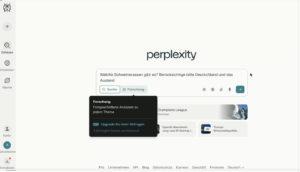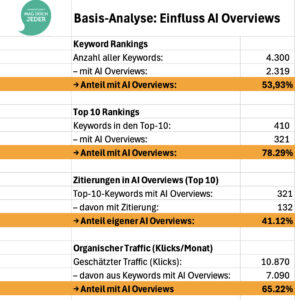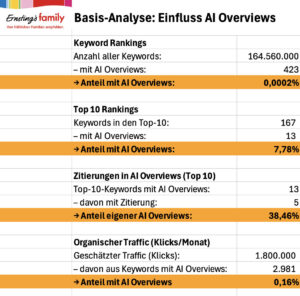Web search is changing: Google and co. are increasingly providing direct AI answers instead of just a list of blue links. Nevertheless, there are indications that good rankings in the classic search results play a role when it comes to whether companies and their content are considered in such response formats.
Common language models such as Gemini 2.5, ChatGPT with Browsing (GPT-4o) or Perplexity AI do not just rely on their training knowledge. If a query goes beyond this, they carry out a web search in real time and then summarize the information found into an answer. This principle is called Retrieval Augmented Generation (RAG).

A central component of this principle is the so-called query fan-out: the original search query is broken down internally into several smaller subqueries. Specific information is searched for each of these subqueries before an answer is generated. Google has confirmed that precisely this process will be used in the new AI mode of search. Even if it has not been officially confirmed for AI Overviews, many SEOs (e.g. Hanns Kronenberg or Olaf Kopp) assume that a similar mechanism is used there.
While good rankings are no guarantee of being cited in AI responses (see Sistrix Top 50 domains with share of AI overviews), they seem to logically play a role in the composition of this content. This raises a fundamental question: If large language models increasingly rely on search results to generate answers – will the classic blue links be clicked less by humans in the future and instead be used primarily by machines?
WHAT IS THE IMPACT OF AI OVERVIEWS ON MY COMPANY?
To better understand the specific impact of this development, it is worth taking a look at when and how AI overviews are displayed on Google. They occur particularly frequently for informative search queries – especially in subject areas that are fact-based, structured or clearly defined (e.g. health, law, finance, insurance, education or technology). Longer search queries with more than five words also appear to increase the likelihood of being displayed. This is not only reflected in the observations of the SEO community, but also in our own work.
At the same time, it is clear that the display of results still varies on a daily basis in some cases. Nevertheless, to get an initial feel for the influence of AI overviews, we carry out a basic analysis for many of our clients. In terms of methodology, it is based on what Hanns Kronenberg presented in his talk at the Search Seekers Conference – a structured approach to a system that is still being developed.
In this example, we use data from Conductor’s Research tab to analyze the visibility of keywords in the context of AI Overviews. Of course, the analysis could be carried out even more precisely using your own web analytics data from the Google Search Console.
BASIC ANALYSIS OF AI OVERVIEWS FOR EVERYONE

A particularly suitable example for an initial analysis of the influence of AI overviews is our agricultural campaign MAG DOCH JEDER. The associated domain has numerous constant top rankings in its topic area, which serve a clearly informative search intention.
The analysis clearly shows that AI Overviews have a noticeable impact on the organic visibility of the domain. An AI Overview is currently displayed in almost 78% of the top 10 rankings for relevant keywords. Remarkably, in42% of these cases, the domain is actually cited as a source – without targeted optimization for AI Overviews. Solid SEO groundwork is therefore also paying off in the new context of AI-supported search.
BASIC ANALYSIS OF AI OVERVIEWS AT ERNSTING’S FAMILY GMBH & CO. KG

Another example of the analysis of the influence of AI Overviews is Ernsting’s family – the most visible company in Münsterland according to our Top 50 study from February 2024. Here, there is significantly less overlap with AI Overviews.
Of over 164 million ranking keywords, only 423 are terms for which AI Overviews are displayed – this corresponds to just 0.0002%. In the top 10 rankings, the share is 7.78%, and the domain is also named as a source in five cases for 13 of the keywords concerned. The share of estimated organic traffic from AI overview keywords is currently only 0.16%.
This is not surprising: the domain is primarily displayed for transactional search queries. AI Overviews, on the other hand, mainly appear for informative search intentions – after all, Google doesn’t want to ruin its advertising business. The first tests with advertising within the Overviews have already been carried out in the USA. It remains to be seen where this development will lead.
CONCLUSION: THE INFLUENCE OF AI OVERVIEWS IS VERY INDIVIDUAL
AI Overviews are more than just a new feature in Google Search – they mark a structural change in the presentation of results. This is based on the principle of Retrieval Augmented Generation (RAG): language models actively access current search results and automatically summarize the information.
Our analyses show that classic SEO rankings can have an influence on the selection and citation in AI overviews – with very different characteristics depending on the keyword, search intention and industry. While structured, informative content is cited more frequently, transactional search queries have hardly played a role to date.
We can analyze how big the actual impact on your online business is – feel free to contact us. And perhaps the AI Overviews are just a stopover on the way to fully generative AI Mode. One thing is clear: search is on the move.
In the following articles, we will therefore take a closer look at the next relevant topics: Which metrics will really count in the future? How will click behavior change with AI overviews? And how can content be specifically optimized for citation within these formats?
Anyone who wants to shape search successfully in the long term must not only observe the new rules of the game, but actively question them. We’re staying on top of it – and sharing our findings.

